What would have happened if John Lennon had never met Paul McCartney? Or, if Paul Simon had never become part of Simon & Garfunkel?
In business — as in music — success rarely occurs without a group effort. Unsurprisingly, most companies today base their operations on collaborative principles.
We’ll review the main benefits of collaboration to illustrate its value and see its effects on communication and innovation.
Without further ado, let’s jump in!
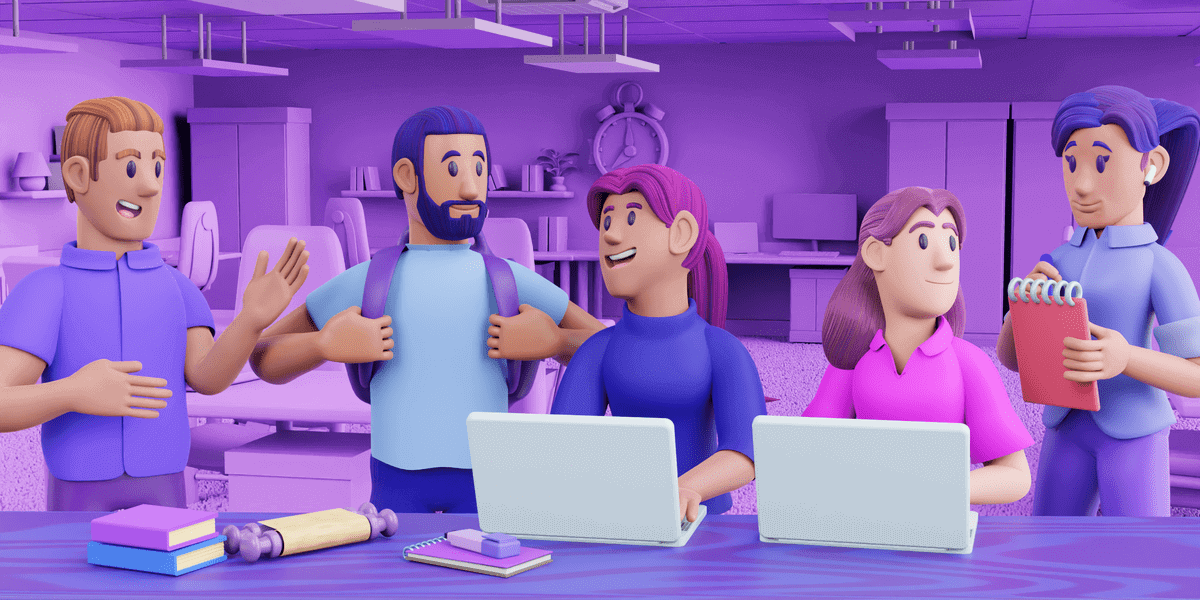
What is collaboration?
Collaboration refers to the act of working together with other people with the aim of achieving a shared goal.
Although teamwork and collaboration are often used interchangeably, the 2 terms refer to different processes.
Namely, when team members are committed to a shared vision but primarily work independently during a project, we are talking about teamwork. Team collaboration, on the other hand, occurs when group members tap into different collaboration skills, some of which include:
- Effective communication with peers and superiors,
- Prioritizing team goals rather than personal pursuits, and
- Reading the nonverbal communication of your teammates.
Rather than competing with each other, coworkers should be able to push past their competitiveness and work together as a unit.
So, leadership and management should group employees whose work preferences and communication styles align — at least to a certain extent. Once the team gets into a familiar rhythm and trust increases, we can prepare to reap the benefits of team collaboration.
🎓 Pumble Pro Tip
As we are about to review its benefits, you might be curious about some other reasons team collaboration matters. To learn more, head to this exhaustive guide:
Team collaboration: Benefits and examples
We’ve defined employee collaboration, but what are its concrete benefits? In the following paragraphs, we’ll explore them in greater detail and illustrate each point through examples.
Benefit #1: Collaboration fuels innovation and problem solving
When 2 or more coworkers come together and intertwine their different skills and perspectives, they collectively bolster the team’s collective:
- Competence,
- Ability, and
- Experience.
Thanks to diverse expertise and a multitude of viewpoints, we can tackle challenges that would have baffled us had we been working alone. But, when we have others working alongside us, we can resolve issues by:
- Asking for help,
- Group brainstorming sessions, or
- Active communication.
Moreover, exposure to different ideas and approaches to work compels people to reexamine their perspectives, which can be a strong catalyst for new ideas. Not to mention that the constant flow of information leads to faster and better responses to any new developments.
Example of collaboration fueling problem solving
How does collaboration change things for a team overhauling an outdated app? Let’s take a look.
As the app first launched several years ago, the team expected some challenges, but the problems in the code were more significant than they had expected. They scheduled a meeting to discuss how to approach the issues, and both the quality assurance specialist and UX designer explained how they believed the team should move forward. As the meeting came to a close, each team member voiced their opinion, and the group had a better idea of:
- Potential deadlines,
- Individual responsibilities, and
- Task assignment.
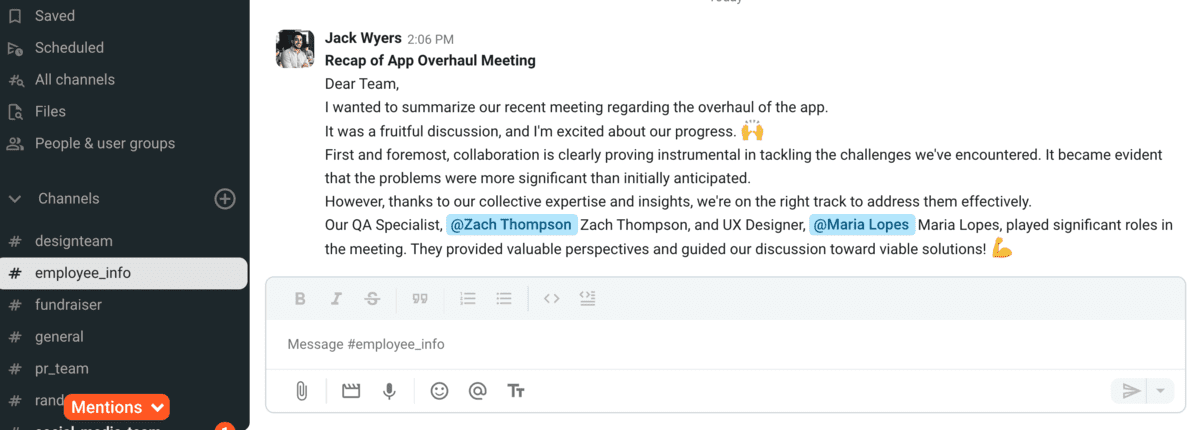
Pumble simplifies problem solving
Had each team member been left to their own devices, solving this problem would have eaten up too much time and effort.
Benefit #2: Collaboration increases knowledge sharing and improves the flow of information
Organizations that want to maximize team collaboration benefits usually focus on knowledge management, and with good reason.
Even in a startup or small business, there are several experts who excel in different areas, making it all the more essential to maintain and disseminate this collective expertise throughout the company.
Collaboration is a necessary trigger for knowledge sharing, as it:
- Brings together people with diverging skills,
- Opens communication lines between collaborators, and
- Enables direct knowledge transfer through group work.
The above points are integral for cross-functional collaboration, which gathers professionals who don’t usually work together, thus allowing them to share unique insights and perspectives they would not be exposed to in usual circumstances.
This type of collaborative work can also go a long way in eliminating information silos, making organizations better prepared to face future challenges.
Example of collaboration increasing knowledge sharing
Any group work involves a degree of knowledge sharing, and this only increases when we become part of a larger project, as is the case with the following example.
A design agency is working with a new client, and the stakeholders want an overhaul of the old website and a completely new visual identity.
Because there’s only so much designers can do when reworking a website, they work together with web developers to ensure each visual element looks perfect on the web, learning more about their job from a programming perspective.
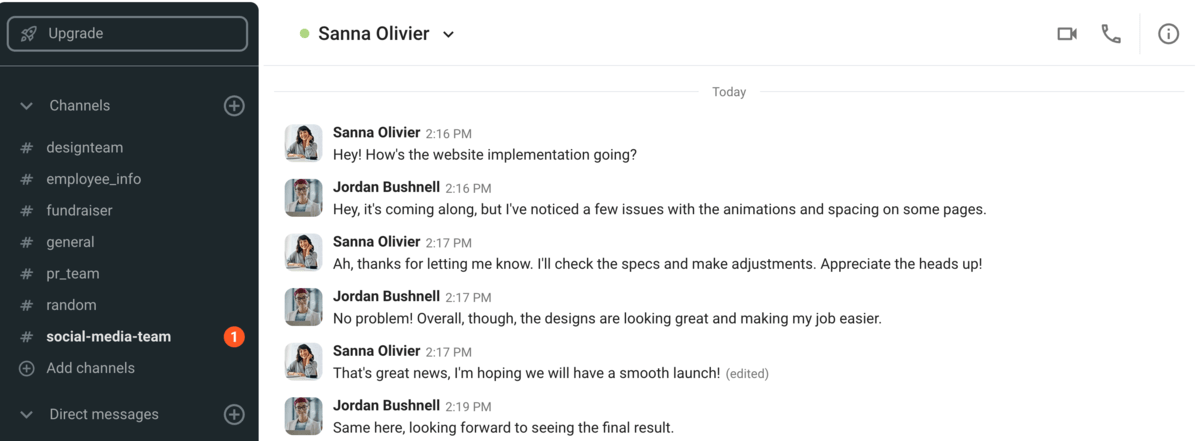
Ironing out issues with dynamic elements and UI interactions takes a lot of back and forth. As a result of their collaboration, the new website has a recognizable look with cohesive elements that meet the client’s needs.
🎓 Pumble Pro Tip
Interested in learning more about the benefits of cross-functional teams and collaboration? If so, check out this detailed guide:
Benefit #3: Collaboration strengthens interpersonal relationships
Collaborative work brings team members closer to one another and spurs them to work together on a shared goal. This type of environment improves interpersonal relationships among collaborators, which strengthens not only their mutual bonds but also their commitment to their:
- Shared work,
- Team, and
- Organization as a whole.
Consequently, team members invest more effort into their tasks and feel a higher degree of motivation.
This is especially important for coworkers who belong to different departments and may not get many opportunities to work together. Mutual engagement and collaboration improve the connections between different departments, creating a broader sense of belonging that extends beyond the collaborators’ primary teams.
Example of collaboration strengthening interpersonal relationships
If you rarely have the chance to work with different departments, it might be challenging to imagine starting over in a team with new coworkers.
But, as our example below shows, these situations can lead to outstanding results.
A fintech company has decided to participate in a charity fundraiser, so a cross-department team has the task of organizing a company-wide event to raise funds.
The team will have to start with task allocation. For example, the social media specialist will spread the word about the event across different platforms, while the accounting clerk will handle the budgeting.
At first, their interactions may only occur during formal meetings, but over time, they may meet for lunch breaks or drinks after work.
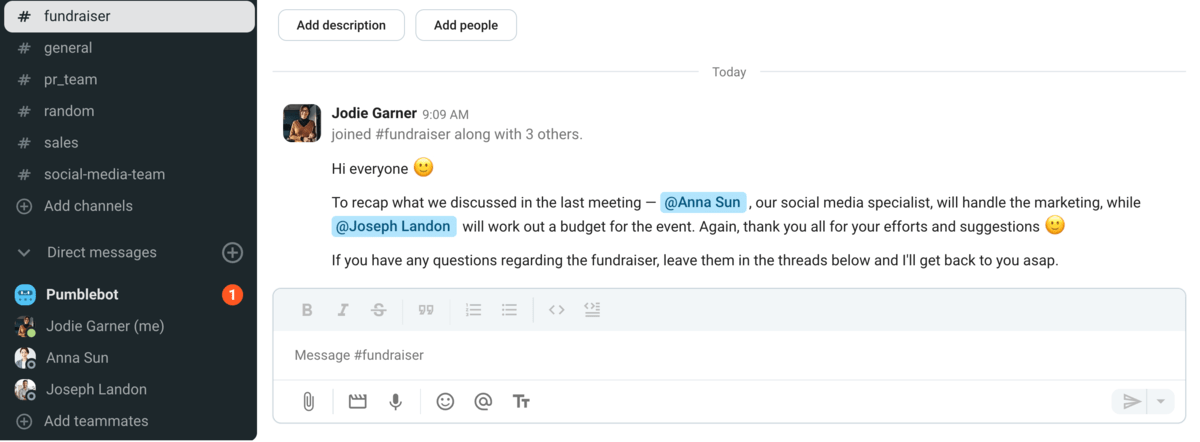
Enhance your team connection with Pumble
All these meetings will help the team members connect on a deeper level as they share personal stories or workplace anecdotes. And, as this personal connection deepens, it will also strengthen their professional relationships.
Benefit #4: Collaboration increases alignment across different departments
As we’ve mentioned, when your team works with a different department, the experience paints a broader picture of how the contribution of each person leads to a larger goal.
This insight leads to a better understanding of different team roles within the broader framework and helps ensure that all departments stay on the same page and focus on their common goal.
Example of collaboration increasing alignment across different departments
If we were never to connect with different teams, we’d probably fail to take in all sides of a project. Luckily, that’s not what happens in our example.
In a software development company, the product development team has been working on a new application that aims to streamline project management for businesses. However, the marketing team has seen a gap between the features being developed and the messaging needed to effectively promote the software to future clients.
In the past, such mishaps would have resulted in delays in product launches and disjointed marketing efforts. However, this time, the company decided to foster collaboration with:
- Feedback loops,
- Joint decision making, and
- Cross-functional meetings.
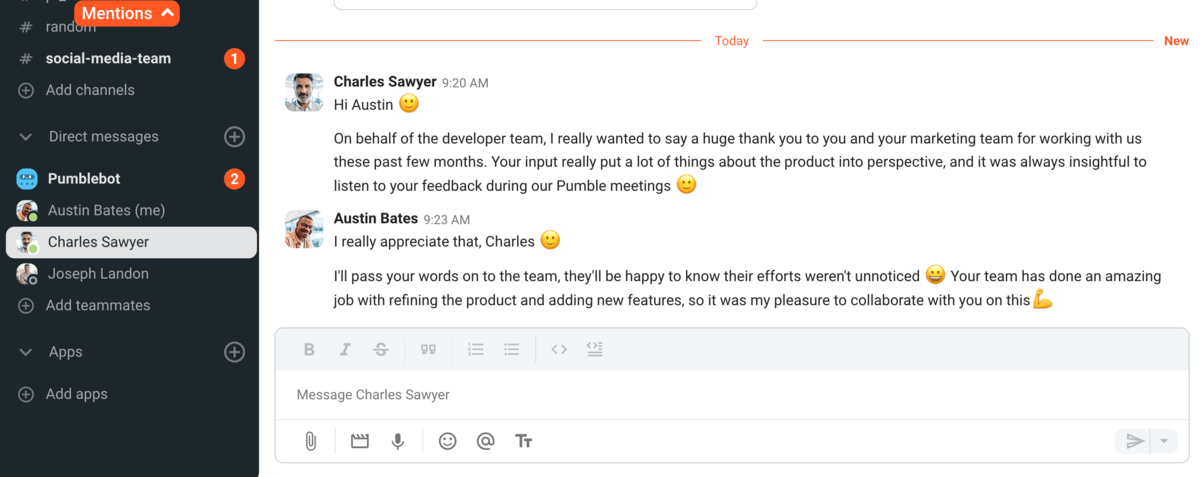
Thanks to these practices, the results of their cross-functional collaboration kept the teams aligned during all phases of the project.
Benefit #5: Collaboration reinforces company culture
Quality collaboration promotes a culture founded on values such as:
- Transparency,
- Teamwork,
- Trust, and
- Support.
Creating a community within an organization begins with identifying core values, which encourage commitment to a common goal. When everyone uses these values as guideposts, it’s much easier to:
- Communicate openly and
- Lead with empathy.
However, to reap the benefits of collaboration in the workplace, your team should consistently apply the company’s core values in their everyday interactions.
Moreover, the organization should prioritize psychological safety and trust to make sure all employees feel empowered and motivated.
For example, employers can show trust by:
- Offering flexible work hours,
- Allowing people to work remotely for part of the week, or
- Avoiding micromanaging.
Once employees feel psychologically safe, they’ll be more open to making mistakes and learning new skills without fearing negative repercussions. When we have trust and psychological safety, employee experience soars, which boosts employee morale.
Example of collaboration reinforcing company culture
To see how collaboration can enforce an organization’s culture and identity, we’ll look at a design agency where Charles is the team lead. His primary goal is to foster teamwork and support his colleagues.

Thanks to Charles’s efforts and the agency’s flexible work policy, the team is constantly sharing knowledge and ideas, and this collaborative spirit aligns with the company’s identity. In this case, Charles is an example of what a good manager should do for their team — nurture the feeling of shared purpose and belonging.
Benefit #6: Collaboration leads to higher retention rates
One of the main benefits of collaboration for businesses is higher retention rates.
Since collaboration infuses everyday tasks with value and meaning, it highlights team accomplishments instead of individual successes, fostering stronger bonds among the collaborators. And, when employees feel appreciated and engaged, they’re more likely to stay with a company.
Remember that retention is about much more than retaining staff — it’s about creating an atmosphere that inspires people to put their best foot forward as they work together to achieve organizational goals.
To achieve this kind of positive workplace environment, employers may need to:
- Adopt performance-based incentives,
- Offer more flexible working arrangements, and
- Provide more comprehensive benefits packages.
Example of collaboration leading to higher retention rates
Startups are known for being fast-paced environments, but with healthy collaboration tactics, you don’t have to worry about your top performers stepping away.
Jordan and his tech startup squad — comprised of Maureen, Charlie, and Alistair — have worked together for 2 years. It took a while for the group to find their rhythm, but once they started bouncing ideas off each other and pooling their expertise, no coding challenge could stand in their way.
Jordan actively listens to his team and praises every contribution, compounding the sense of shared achievement and camaraderie. As a result, the team members enjoy the connections they’ve formed and are likely to stay part of the startup for the long haul.

Benefit #7: Collaboration increases productivity
Once we replace unhealthy competition with collaboration, productivity flourishes.
To some people, the question “What is collaboration?” conjures up an image of a group of people huddled over a table, chipping away at an important project. Most of the time, collaboration is about small interactions, like asking a colleague for feedback or guidance.
With the rise of cloud-based solutions for digital collaboration, gathering information from colleagues working in different departments is much easier. So, productivity explodes because we can handle administrative tasks swiftly thanks to digital tools. On the other hand, real-time communication remains the vessel for ironing out mistakes and finding new approaches or solutions.
Example of collaboration increasing productivity
When a project’s scope exceeds our capabilities, it’s easy to feel overwhelmed and experience work overload.
Fortunately, that’s not what happens to Lana in her architecture firm. She has landed a new renovation project, so she enlists Jackson, an interior designer, and Richard, a construction supervisor, to help complete everything on time. She feels a bit apprehensive about working with independent contractors, but there’s no need for concerns.
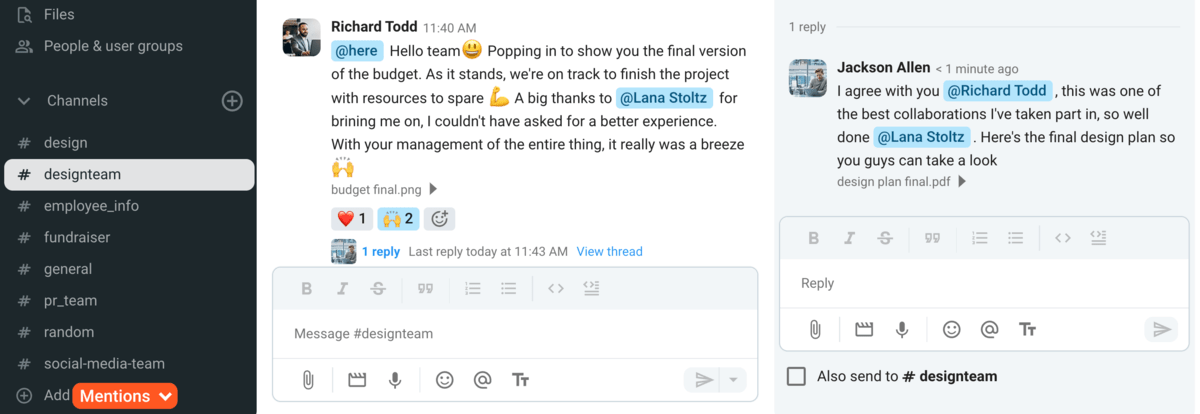
Jackson’s interior designs ooze functionality and creativity, while Richard’s management expertise ensures the team doesn’t exceed their budget. Coupled with Lana’s task allocation, their efforts optimize productivity, and the final result satisfies the client’s needs.
Benefit #8: Collaboration expands our skillset
All collaborative work gathers a wide range of talents with different strengths, and the result of their efforts is often greater than the sum of its parts.
This experience provides insights into different skill sets and expertise, prompting collaborators to learn from each other and reexamine their approaches.
Every collaboration is a learning experience — even if we aren’t embracing new knowledge and skills, constant interaction and constructive feedback enable us to adjust and improve our way of doing things.
Additionally, collaborative settings are the perfect environment to fast-track the onboarding and knowledge transfer processes for new team members.
Example of collaboration expanding our skillset
What are the benefits of collaboration for interns and young professionals? Let’s see how things panned out for Emma, an intern assigned to assist her more seasoned colleagues on a project.
Her new role involved working with Mina, a software developer, and Tom, an experienced UX designer, on developing a new application.
Tom’s expertise and Mina’s technical skills complemented each other, while Emma brought a fresh perspective and enthusiasm to the group.
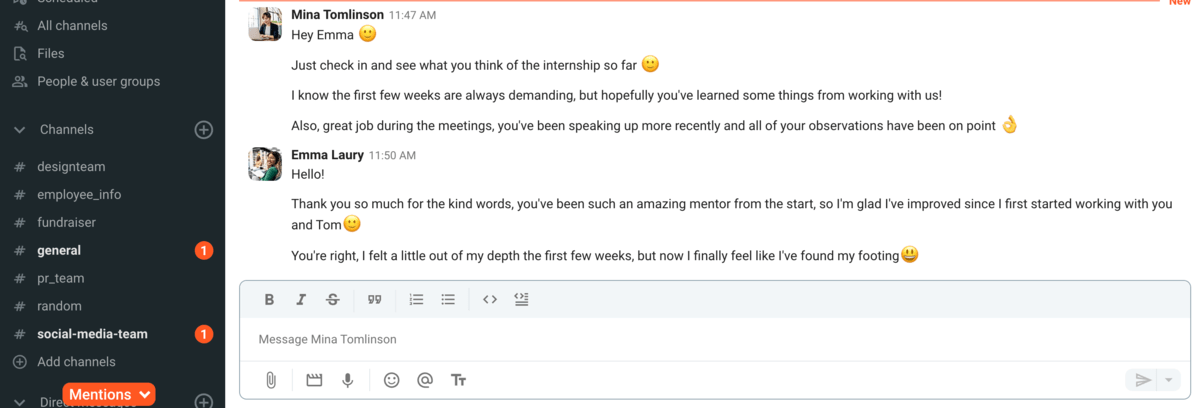
Mina mentored Emma, enriching her leadership and communication skills. Meanwhile, Emma freely voiced her suggestions and learned a lot from her more experienced coworkers, which made her internship all the more enjoyable.
Benefit #9: Collaboration increases our understanding of other disciplines
Collaborating with professionals with varying skill sets is a great way to learn in a practical and direct manner.
We get the opportunity to observe their approach and thought process, although their field of expertise is different from ours. These experiences grant us a new perspective by urging us to understand how different professions and roles fit into the bigger picture of the organization and its goals. Not to mention that we have to use and sharpen our interpersonal and collaborative skills any time we come into contact with a diverse range of:
- Methodologies,
- Motivations, and
- Viewpoints.
Understanding and embracing this diversity is one of the crucial benefits of collaboration.
Example of collaboration increasing our understanding of other disciplines
When you don’t know enough about your colleagues’ work, it’s easy to underestimate their contributions. Yet, your opinion might change when you get a front-seat view of what their job entails.
Jeremy, a UX designer, found himself in this situation and messaged Doris, a technical writer, to tell her how his view had shifted.

Use Pumble to improve cross-functional collaboration
Benefit #10: Collaboration expands our professional network
Professional and personal growth are some of the most valuable perks of collaboration in the workplace. But, another benefit of collaboration is the opportunity to grow our professional network. The more people we come into contact with from our field or related industries, the more chance we have of finding new:
- Mentors,
- Allies,
- Business partners, and
- Collaborators.
The credibility of your connections and the impression you leave on collaborators can advance your career further down the road.
Example of collaboration expanding our personal network
Here’s how Sarah, who was recently promoted to a Marketing Manager position at a tech startup, grew her professional network while working on a product launch.
During the lead-up to the launch, she collaborated with:
- Mark, a graphic designer,
- Lauren, a copywriter, and
- Don, a data analyst.
Although this is the first time they’ve all worked together, they managed to pull off a successful marketing strategy.

Thanks to the experience, Sarah has gained valuable contacts for future career and collaboration opportunities.
Kickstart team collaboration with Pumble
Without quality communication, there can be no collaboration. With Pumble, you can set your team up for success and lay a solid foundation to enhance productivity. Thanks to the platform’s user-friendly features, you can keep discussions structured and focused with:
Not only can you use the screen-sharing and file-sharing features with members of your teams, but you can also grant guest access to external collaborators.
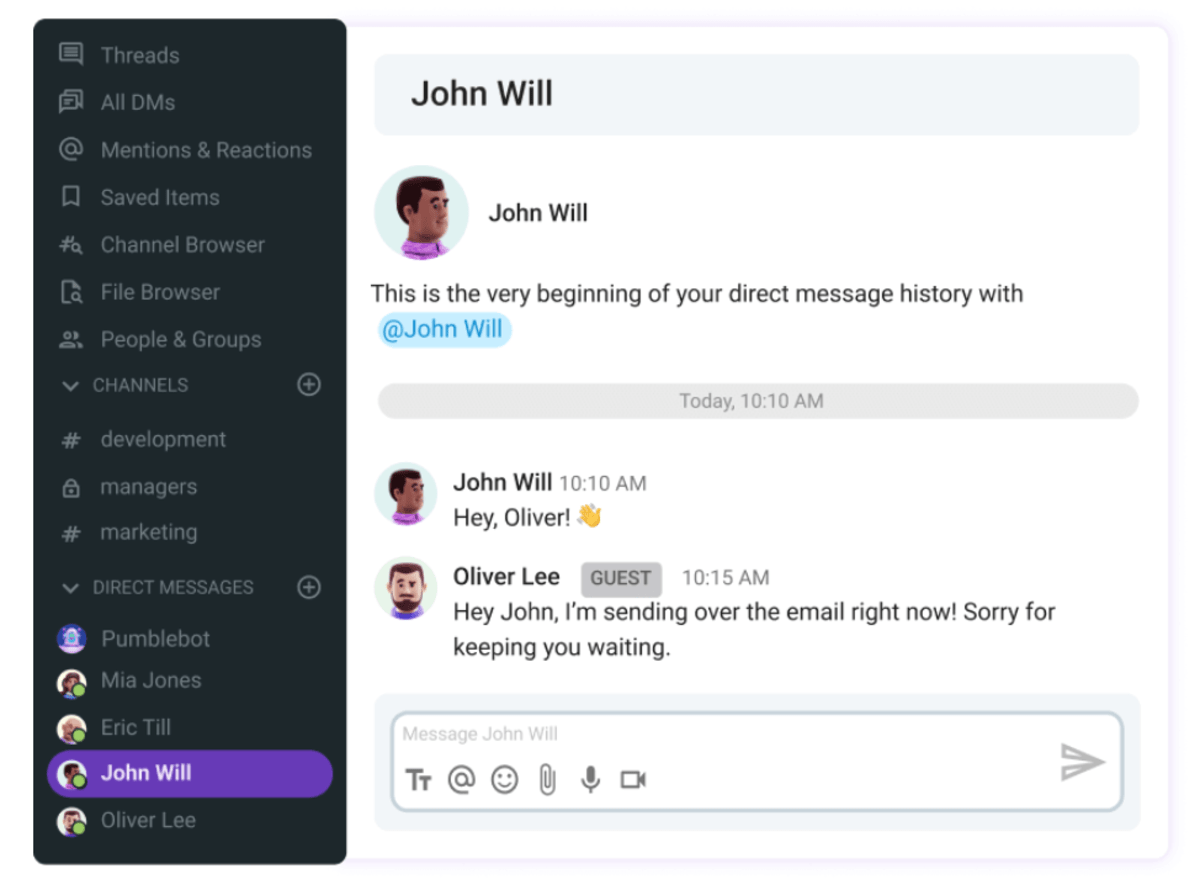
Pumble is available across different platforms, making it easy to promote:
- Problem solving,
- Learning, and
- Strong professional relationships.
Wondering how Pumble can empower your team? Equip your colleagues with the tools they need!
How we reviewed this post: Our writers & editors monitor the posts and update them when new information becomes available, to keep them fresh and relevant.


